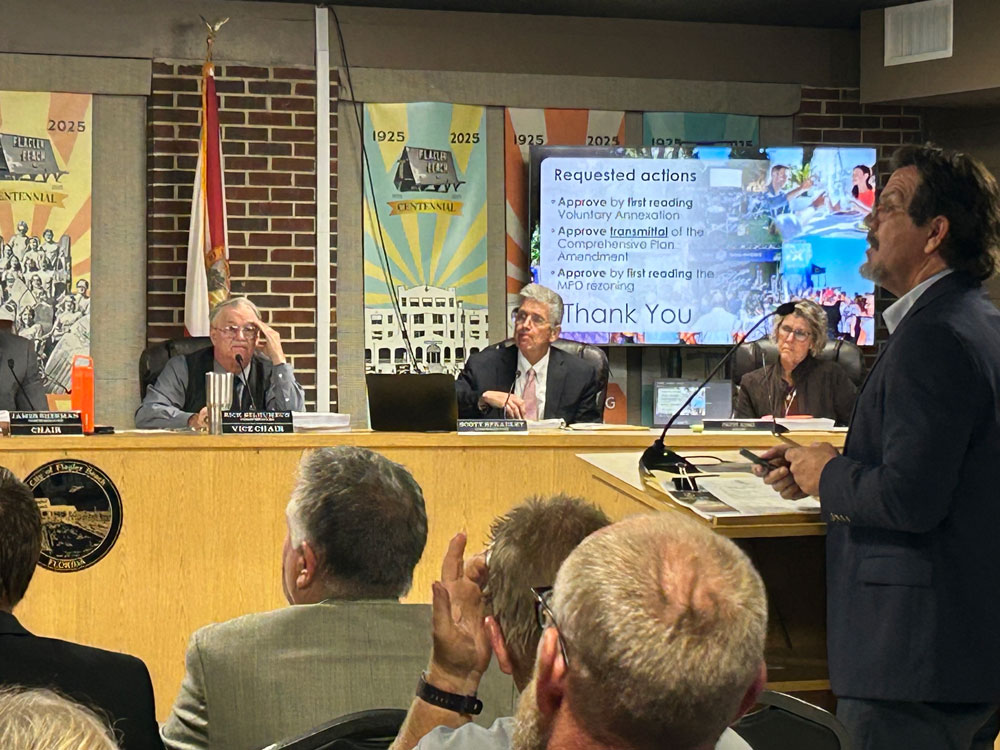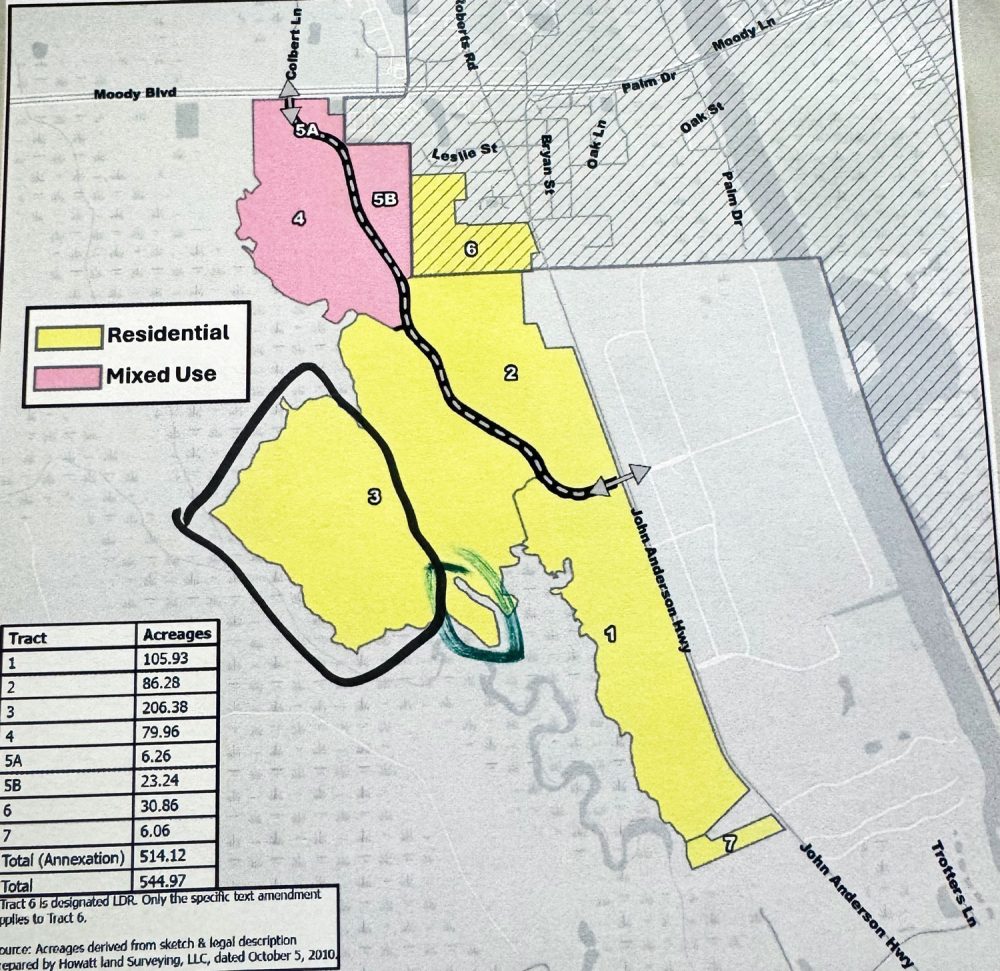
In a momentous step that would reconfigure the city’s boundaries, character and political center of gravity, the Flagler Beach City Commission on Thursday evening voted 4-1 to approve on first reading the annexation of 514 acres on the west side of John Anderson Highway, a segment of the Veranda Bay development that’s been rebranded Summertown and will include a town center-like commercial district.
The annexation would enlarge Flagler Beach’s current acreage of 2,291 by more than a fifth while the population of the annexed land at build-out at 2,400 homes, a few decades in the future, would more than double Flagler Beach’s current population of 5,500.
The developer’s representative, Ken Belshe, also alleviated county and city concerns over the headwaters of Bulow Creek both by agreeing to consider selling the floodplain around it and to pledge against building in a certain area that would impact it. Bulow Creek skirts, but is not at any point inside, the Summertown segment.
“I deeply want to make sure that we preserve the Bulow Creek system for eternity,” County Commission Chair Andy Dance said.
“We are a willing seller,” Michael Chiumento, the land-use attorney representing the developer, said of the county’s efforts to buy land. “If they find land that they think is environmentally sensitive that meets the requirement of their purchase, we’re all ears, and we’ll sit down.”

Second and final reading is scheduled for January. A workshop on the matter, suggested by Flagler Beach resident Irwin Connelly, will take place before then. “We’ve got 60 days to work and fine-tune some of these things,” City Commissioner Scott Spradley said.
The city commission tabled until then approval of the proposed 211-acre annexation on the east side of John Anderson Highway. That segment of the development, still called Veranda Bay, includes many occupied properties whose 118 owners have not signed off on annexation. Their approval is required before annexation can happen. (The 2,400-home total includes both sides of John Anderson.)
Commissioners Rick Belhumeur, who made the motion for approval, Spradley, James Sherman and Eric Cooley voted for annexing Summertown. Commissioner John Cunningham dissented. The vote overrode the recommendation of the city’s planning board, which last October voted down Summertown and Veranda Bay.
“We’re not here because we’re stopping a development or allowing one,” said Jay Gardner, a resident of John Anderson Highway and the county’s property appraiser since 2005. “We could decide whether we want it, we being Flagler Beach. We’re talking about permit fees, impact fees, tax dollars, getting rid of our wastewater. If it’s going to happen, I surely don’t want to see it in the city of Palm Coast. This is really the last opportunity we have to annex something for the tax benefit.”
In contrast with many of the previous hearings on the development over the years, the majority of those who addressed the commission Thursday spoke more along the lines of Gardner’s comments than from anything like outright opposition, with pressure limited to urging the commission to protect the headwaters of Bulow Creek. Several speakers were contractors and builders who spoke glowingly of the developer, and whose presence there appeared to have been orchestrated as a counterweight to the opposition, which was comparatively muted.
“I’m not opposed to annexation. I am opposed to the density,” Barbara Revels, a long-time city resident and a member of its planning board, said. “I’m opposed to the lack of distance to the Bulow Creek headwaters, which sounds like to me, there’s been some great headway tonight. Thank you very much for that and how that may develop. I’m opposed to the traffic burden on the existing residents of John Anderson Highway, both in and out of the city.”
Revels also spoke against clear-cutting and the density on the Summertown side, and noted the rising cost of utility bills in preparation for the development.
Matt Hathaway, who’s been among the leaders of the opposition, said “a lot of folks here are not against annexation,” and pressed for the county-led initiative to buy 200 acres out of the Veranda Bay land as a protective measure. He said he had no issue with Summertown and its commercial development, which he said is needed. But environmental protection around Bulow Creek was a different matter. “You have somebody that’s willing to buy it, and I give them a lot of credit that we have a willing seller tonight, which is a great step forward,” he said. “I think it’s amazing that the county actually came here.”
Flagler Beach and Veranda Bay (as both developments will be referred to here, for ease of reference) came close to annexation of 800 acres on both sides of John Anderson last December. Preserve Flagler Beach and Bulow Creek, the non-profit group established to oppose Veranda Bay, threatened to sue over the annexation creating an enclave of county land, which would violate state law. The city commission swiftly tabled the proposal, leaving it to Veranda Bay to resubmit a plan that doesn’t put the city at risk of a lawsuit. That’s the plan the commission had before it Thursday.
The commission’s action does not signal a done deal. None of the regulatory steps for Veranda Bay have been that easy since the development reemerged in 2019, under new ownership, after developer Bobby Ginn had won approval for a different plan in 2005, before he went into bankruptcy and the land was again dormant.
Since 2019, no local development has faced as much opposition, triggered as much litigation and threats of litigation, and worn down drawing boards as has Veranda Bay. It’s a tribute to the fiercely dedicated community in and around Flagler Beach–the core of the opposition is not drawn from Flagler Beach residents, but from residents along unincorporated John Anderson Highway–and of its commission’s diligence.
It’s also a reflection of the developer’s crafty resilience and chess-like strategy of calculated compromise–and at times merciless tactics: the developer twice sued members of the opposition group and twice lost, with the Fifth District Court of Appeal affirming opponents’ victory in one of the suits just last week.

In comparison, the 6,100-home development known as the Reserve at Haw Creek that the Bunnell City Commission just approved barreled through regulatory steps, steamrolling near-unanimous public opposition (and a more voluminous one than Flagler Beach’s against Veranda Bay), with minor changes, as if the deal had been guaranteed approval in Bunnell’s opaque back-offices from the get-go.
Spradley Thursday evening acknowledged “heartfelt testimony from a lot of the residents around here, both for and against,” but also “some positive movement from the developer when it comes to conservation.”
Veranda Bay/Summertown are represented by Belshe of SunBelt Land Management, itself represented by Chiumento and Jay Livingston, the Palm Coast land use attorneys (from different firms).
“It’s real simple,” Commissioner Cooley said. “If you don’t annex it, you’re out. You have no control over nothing. You’re not protecting Bulow. You’re not protecting the city. You’re not protecting anything. You’re turning it over to the universe, whoever decides that they want to have control over that land.”
He recalled the 2020 hearing when Veranda Bay, then known as the Gardens, was seeking development approval for 335 houses from the county. Flagler Beach had concerns and asked the county to impose four conditions addressing flooding, recycled water, traffic and future development.
“We got categorically ignored,” Cooley said. The county approved the development. Flagler Beach last year approached the developer to considering annexing, to gain control. “Let’s say we don’t annex. You have two options, County or Palm Coast. Do either one of those municipalities have Flagler Beach’s best interest at heart? So if you don’t annex, you’re out of the conversation. Not only conversation, but there’s a high likelihood, as we’ve already seen from previous interactions, that if we do have any concerns about what somebody wants to do over there, it’s just going to get blown off again.”
The commission’s approval included votes on amending the comprehensive plan, the blueprint for long-term growth management. That amendment must be forwarded to state agencies for review, though that step has become more cursory than regulatory. It is limited to questions and recommendations, not mandated requirements, making it more of a formality than a potential obstacle.
![]()
The full back-up documentation on the annexation proposal is here.




























Kp says
Bravo! We need the control and the revenue. Well done.
Steve says
It just slows a little the slow death of a beautiful small beach town. To many houses. To much new paved over open land. Less open space. The character forever changes. True control would be very limited building. As for revenue I still have never been shown any and I mean any benefit of the supposed increase in revenue. I always pay more in taxes and never see better roads, water treatment, trash pickup, fire protection, police protection, schools, etc.. Pretty much the quality of life of what was is gone. All places are not meant to be overcrowded, over built, over paved!!
Darlene Shelley says
Hypocrites! God forbid it should affect the affluent. Toxic lead and chemicals have been polluting Bulow Creek, Black Branch, Graham Swamp, and the Intracoastal Waterway ever since Flagler County and poor airport management invited thousands of piston engine flight school aircraft to perform hundreds of daily low, loud, and leaded dangerous touch and go maneuvers over our homes in Palm Coast and Bunell. For free! Hundreds of pounds of toxic lead every year washing into our canals and waterways and leaching into the environment. Bulow Creek Ruins test site of Saint John’s Water Management District showed a fivefold increase in lead results in just three years. THESE PEOPLE KNOW THAT THERE IS NO SAFE LEVEL OF LEAD AND HOWTERRIBLY HARMFUL IT IS TO CHILDREN! Yet here they are again, feigning concern for Bulow Creek, accepting awards for protecting health and safety, pretending this is not a disaster playing out in slow motion, and waiting for the next aviation catastrophe. Excessive training aircraft operations are incompatible, unsafe, and a serious threat to public safety, health, and welfare for all residents of Palm Coast, Bunnell, and Flagler County, and that is the REAL threat to Bulow Creek, local residents, quality of life, and OUR CHILDREN!
Keep Flagler Natural says
Hell no! Keep Flagler natural!! And green!! “When all the rivers are poisoned, and all the trees are gone you will soon learn you cannot eat money”. To many people moving to the east side of the county. The infrastructure can’t handle it. What is with these boomers in the area who think this is a good thing.